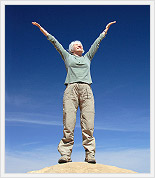|
|
Exercise and Bone Density
QUESTION:
My doctor said that exercise is good for my bones. Are there specific types of exercise that are better than others? How does exercise actually help my bones?
ANSWER:
 Taking the appropriate measures to ensure strong bones throughout the lifespan is a smart move. Osteoporosis, a disease in which bone mineral density deteriorates, increases the risk for bone fractures and can be devastating. Quality of life and functional abilities are often affected to the point of disability. In fact, the mortality rate for elderly individuals following a hip fracture is as high as 20% in the first year. Taking the appropriate measures to ensure strong bones throughout the lifespan is a smart move. Osteoporosis, a disease in which bone mineral density deteriorates, increases the risk for bone fractures and can be devastating. Quality of life and functional abilities are often affected to the point of disability. In fact, the mortality rate for elderly individuals following a hip fracture is as high as 20% in the first year.
Once again exercise comes to the rescue. Not only can exercise maintain or increase bone mineral density (BMD), it can reduce the risk of falling by increasing fitness level, muscle strength and coordination. The American College of Sports Medicine suggests that exercise can play an important role in bone health throughout the lifespan by:
- Maximizing bone mass during childhood and early adulthood
- Maintaining bone mass through the fifth decade of life
- Attenuating bone loss associated with aging
- Reducing falls and fractures in the elderly
Although we frequently think of bones as being static, bones are actually dynamic tissues that are constantly breaking down and re-building. One cycle of bone resorption, formation, and mineralization takes 3 to 4 months.
To ensure that our bones stay strong throughout life, it is important that we 1) ingest adequate calcium, and 2) overload our bones with weight-bearing exercise. The "weight-bearing" portion of this recommendation is key. For the exercise to be effective in maintaining bone strength, it must follow the "overload" principle. In other words, the exercise must apply a force to the bone that will "stress" it and thus stimulate it to "adapt" to the exercise. Bones respond to weight-bearing exercise by strengthening themselves.
There are many types of exercise that can fit the bill of "weight-bearing". Jogging, high intensity resistance training, stair climbing/descending, and activities that involve jumping (volleyball, tennis, basketball, soccer, jump-roping, plyometrics, etc.) are effective modes. The following guidelines can maximize effectiveness:
 |
Intensity: |
moderate to high |
| Frequency: |
3 - 5 days a week (weight-bearing endurance) |
| |
2 - 3 days a week (resistance training) |
| Duration: |
30 - 60 minutes (combination of both types) |
In contrast, swimming and cycling offer minimal stimulation of bone mineral. Thus, if cycling or swimming is your primary exercise mode, you should incorporate weight-bearing exercise into your routine.
Keep in mind that there are still many questions concerning exercise and bone loss in postmenopausal women. If you fall into this category, it is important that you work with your healthcare provider to design the best bone health strategy for you.


Our expert, Dr. Sharon E. Griffin, holds a B.S., M.S., and Ph.D. in the areas of exercise science/physiology. She also holds a second M.S. degree in Nutrition and is a licensed nutritionist and an ACSM certified health and fitness instructor.
|

